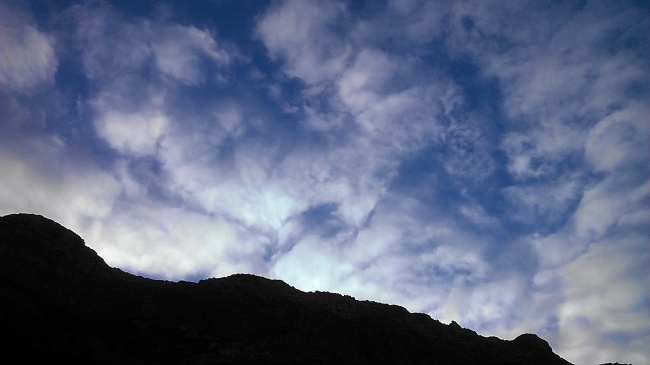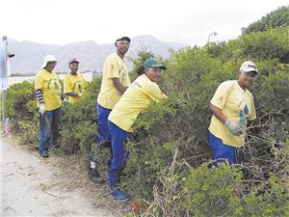Bluegummers survive at the brink of the clouds.
Sandwiched between watery sea and watery sky, our abode is a speck of sweet water just before it melds into the sickly salty sea.
We don’t have conveyance systems, pumps, or wastewater stations. Our reservoir is small enough for preschool kids like Tawana to play in. All we have is the mountain, its gravity pumping the waters down, its kloofs funneling them toward the sea, its granite and fynbos filtering the waters to purity.
coasting on the coattails of summer winds, a carpet of cloud streaks across the Blue Gums ridge
We live willingly at the clouds’ whim, through winter storms and (usually) dry summers. Without any municipal pipes, it’s the summers that cause worry. But luckily the summer brings winds as well, as the Cape Doctor whips toward us from Antarctica; throughout the dry season, the Doctor’s clouds collide into our mountainous ridge, allowing the stream to flow through the summer. Lying on our backs after a long day’s work, we watch the clouds stream by, whisked on the wind, streaking over the peak. Sometimes, if we’re lucky, the summer day turns dark and a mist envelopes the escarpment, transforming it into a mysterious vertical wonderland, where familiar outcroppings suddenly become hideouts, and patches of shrubs become thickets of adventure.
But it’s usually sun in the summer. Hot, merciless, inconveniently-determined-to-burn sun. In the midst of work on a hot day, singing helps keep the mind off the heat. In dedication to the relief of a cloud burst, there’s a Xhosa gospel song that often comes to mind while on the mountain (which I’ve adopted to a more secular enviro-industrial tilt):
Bayeza, bayeza, amanzi phezulu, onke amehlo ayakhumbona
[They’re coming, they’re coming, the waters from above, all of the eyes are watching it]
Simbonesiza sinzengamafu, onke amehlo ayakhumbona
[We see it coming upon the clouds, all of the eyes are watching it!]
Amidst beads of sweat, our pursuit of the never-ending weeds progresses upstream and approaches the waterfall, our own misty paradise, where specks of water fling through sunrays into golden illumination.
And at the end of the long day, a dip in the pond and a refreshingly cool glass of cloudwater.















